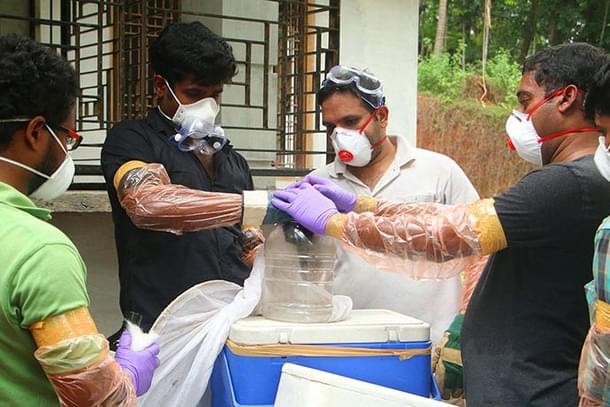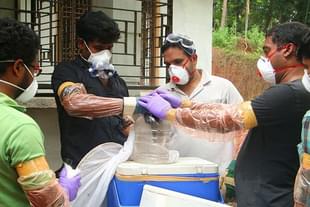Science
Holi, Coronavirus, And The Indian Response: Better To Be Cautious Than Be Foolishly Brave
Prashant Kulkarni
Mar 08, 2020, 01:42 PM | Updated 01:42 PM IST
Save & read from anywhere!
Bookmark stories for easy access on any device or the Swarajya app.


The last few days have seen disturbing reports of incidence of coronavirus in India.
To add to a couple of Indians diagnosed are around 15 Italian tourists. Now, family members of an Indian suffering from coronavirus have tested positive.
Quarantine has been imposed on children of a Noida school for attending the birthday party of a kid of one of the infected.
Government measures are indicating the possibility of having to accommodate more than 2,500 in quarantine facility.
Armed forces and paramilitary forces are being readied for any eventuality. The multi-nation naval exercise, Milan, has been postponed. PM Modi and Home Minster Amit Shah have decided to abstain from Holi Milan festivities.
Implied in their message is the persuasive call to not celebrate or participate in Holi festivities and avoid mass gatherings. Political rallies are also being postponed. However, it is pertinent to analyse the same in terms of the rationality of the response.
Like any other epidemic, Coronavirus follows what Gladwell might term the ‘law of few, stickiness and power of context’. Given the scale of global travel, the pandemics chart a path of increasing returns, to spread of epidemic.
In Talebian phraseology, it is a fat tail distribution, a prospective ruin event. The event being non ergodic, perhaps, higher reproductive ratio mandates a different cost benefit dynamics rather than conventionally assumed.
China opted for a severe, even high-handed measure to quarantine the whole province of Hubei.
The post “China, Rationality and Pandemic Uncertainty” explores in depth the probable rationality of China’s decision to large scale quarantine irrespective of long term consequences.
It would be relevant to examine the Indian conditions on a similar pattern.
Given the nature of Coronavirus, it is inevitable that the virus gets a catalyst to spread in mass gatherings.
In South Korea, it was a prayer meeting of a fringe Christian cult that become ground zero for spreading the virus.
In Iran, it was the Shia religious centre of Qom that became the ground zero for the epidemic.
In both cases, it involved large gatherings that allowed the infected to mingle with the others, thus enabling the spread.
What globalisation in terms of extended reach is doing is to globalise the virus rather than localise it, as the need of the hour suggests so.
In Italy, it was an alleged athlete who was sent home despite doctors observing the symptoms that spread the disease.
The inter-connectedness between Italy and the rest of Europe aided in the spread of the disease. In fact in China, the original ground zero, the wild meat market of Wuhan, became the focal point.
In other words, what Gladwell suggested as ‘law of few, stickiness and power context’ became the tools for spread of the pandemic. Again in Gladwellian terms, these infected people intermingling with the others at these events became the subconscious connectors, mavens and salespersons of the pandemic.
Therefore, any battle against the pandemic will have to counter the Gladwell propositions.
They need to arrest the spread power of these sub-conscious connectors, mavens and salespersons.
The disease might itself be asymptomatic for days. If it were to be immediately symptomatic, the birthday party of Noida might never have happened.
There is still ambiguity on the number of days before one can safely assume the person is out of danger from contracting the COVID-19.
Therefore, a certain need arises to prevent mass gatherings. To physicist Yaneer Bar-Yan, connectors, mavens and salespersons need what he terms as ‘super-spreader events’ for spreading the pandemic.
Bar-Yan terms the events in Korea, China and Italy as super-spreader events (His analysis is available here.
First thoughts on Superspreader events for Coronavirus and why stopping them is extremely important. Comments welcome @nntaleb pic.twitter.com/g4paJrdG2g
— Yaneer Bar-Yam (@yaneerbaryam) February 28, 2020
Therefore, it mandates a need to go all out to halt those events. Some control in China is evident following large scale quarantine.
Iran’s alleged inability to follow up is, perhaps, causing a large scale crisis that can spill over to the rest of the world.
Yet to some critics, there is a talk of over-reaction. To any crisis at hand, reactions assume two shapes. One is the precautionary principle and second is the procrastination principle.
The latter theorises the situation to be dealt as and when it arises. Therefore, in the latter paradigm, unless COVID-19 blows into a full-fledged crisis, an over-reaction is unwarranted.
Yet to others, given the possibility of a ruin event, it is better to be cautious than be foolishly brave.
Therefore, it makes sense to go in for hard actions that might even convey a signal of paranoia. It is better to be paranoid than foolish.
India is about to celebrate Holi, a large-scale mass festival of colours. There are large gatherings and people move across the town playing colours with friends and strangers alike.
There is no way to identify asymptomatic connectors or mavens or salespersons of coronavirus in the large crowds and the joyous festivities it generates.
The reproductive ratio of COVID-19 being in excess of three can complicate matters.
There is the high probability of people getting infected by coming into contact with the asymptomatic carriers of the virus.
As evidence from China and other places show, it is an occasion that is fraught with high danger.
Moreover, given the sheer population of India and the intermingling at the public places all point out towards those propositions of Gladwell, Taleb, Bar-Yar and others.
In fact, the Indian administration has not demonstrated the paranoid scenario as it should have.
There must be quarantine in those areas where most cases are being reported. The gatherings for whatever purposes must be banned.
Even events like marriages etc. should be advised to be extreme low-key and with very few participating people.
To those companies, where remote work is possible, there must be a compulsory mandate to work from home. Schools and colleges can be closed for some time in many parts of the country.
Contact tracing has to happen. In fact, on a war scale, the government must track all those who have come in contact with those infected and precautionary self-quarantine must be imposed.
There must be expansion of quarantine facilities. Rather than focus on treatment post- symptoms, the prevention aspect must be stressed on a war footing.
Sports events, music shows, multiplexes, malls, travel in Mumbai locals — all or any one might be the super-spreader event for the pandemic.
Therefore, trying to curtail the possibility of mass gathering and interaction, conscious or sub-conscious, seems the rational option.
In the given context, the indirect call to desist from Holi is perfectly rational. What is needed is a strong follow up to ensure large gatherings are reduced. The given context also makes it a rational option for the Indian Navy to cancel the exercise ‘Milan’.
Paid holidays might dampen the firms’ earnings, yet, that is what is needed to prevent contact happening in overcrowded public transport that is visible across many cities and towns.
Being paranoid or utterly cautious is rational in economics in the given context.
This piece was originally published on ‘Thoughts on Theory and Practice’ and has been republished here with permission.
Prashant Kulkarni teaches economics, a digital economy and globalization at a leading B-School. His area of interest lies in dissecting resource contestations and human behavior at the intersections of digitization, urbanization and globalization.





